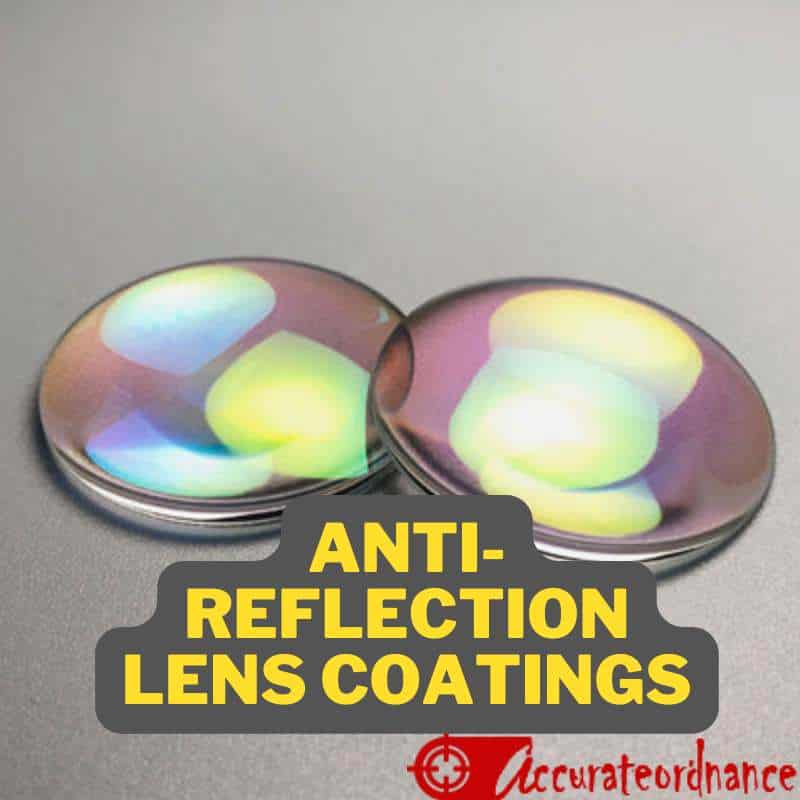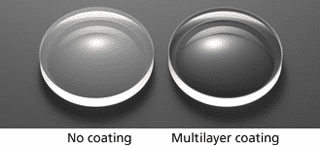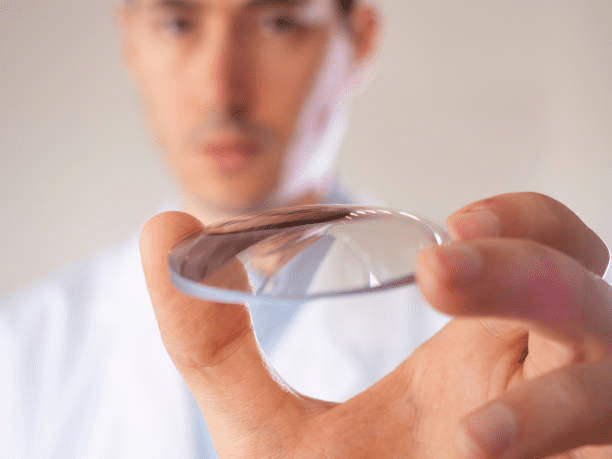Do you know what anti-reflection lens coatings are? If you’ve ever had to purchase a pair of glasses, you should be aware of the numerous lens selections available in the market. But if you’ve not used glasses before now, you’ll find the importance of lens coating here!

The fact is that getting eyeglasses entails more than just picking one based on your eye prescription and selecting a frame that is fancy for you. Choosing the right lens material is an important aspect of getting the perfect pair of glasses for your sight.
And the same thing applies to getting a good rifle scope.
People are now learning the benefits of anti-reflection lens coatings as technology advances. Shooters, drivers, students, and other professionals are now beginning to demand quality lens coating for their various optical devices.
But are anti-glare or anti-reflective lens coatings worthwhile? In this article, we shall be looking at the feature of an anti reflection coating for all types of optics, whether it’s for shooting, driving, or spotting other objects.
Continue reading to find out more about the possible benefits and drawbacks of lens coatings, as well as the impact they can have on any application. Before then, let’s start with what anti reflection coating means.
What Is Anti-reflection Coating?
An anti reflective coating, also called anti-glare coating, keeps reflections off the interior and exterior of an optical instrument (eyeglasses, binoculars, rifle scopes, etc.). When an anti reflective lens reduces reflection in your lens, more light reaches your eyes, improving your vision.
The coating in anti reflective lenses is virtually undetectable by your eyes, so you might not know that they are there.

Optical lens surfaces may be coated for a variety of reasons. Let us use your car’s windows as an example. Your windows most likely have a coating that resists water, minimizes glare, and reduces the heat and light transferred into the interiors of your car. Just like there are glass coatings in your car so also there are anti reflective lenses in different optics including laser rangefinders, rifle scopes, spotting scopes, and binoculars.
Lens coatings serve the same functions and are maintained with the same eyewear cleaners, irrespective of the optical device to which they are applied.
Some Lens Coating Terminology
Before going into detail on the various functions played by lens coatings, several technical words must be defined. Lenses can have one or both surfaces covered. Furthermore, lens coatings can be put in a single or multiple-layer configuration. Some technical terminology you may hear are:

Coated Lens
This is the most fundamental coating found on lenses. In this type of lens coating, some of the lens elements are coated, but not all, and this lens coating is a single-layered anti-reflective coating. The coating is usually applied to the first and last items, which are the only ones visible.
Fully Coated Lens
Fully coated lenses are frequently found on lower-cost optics. In this coating style, all air-to-glass lens surfaces are coated. A single-layer anti-reflection coating is used. While this lens coating is not bad for short-range optics, it is not so good for long-range optics.
Multi-Coated Lens
This signifies that one or more lens has numerous layers of anti reflective AR coating. The outside lens surfaces are often multi-coated, whereas the internal surfaces may just have a single layer anti reflective AR coating. These coated lenses improve light transmittance by reducing the quantity of reflected light that a single-layer coating can’t remove. Multiple layers outperform a single layer by far.
Fully Multi-Coated Lens
This is the king of high-end coatings. In this coating, all the air-glass lens surface is fully multi-coated, which means they have multi-layer anti reflection coatings. This is the best among all the lens coatings, so it is usually found in high-end tactical scopes and long-range scopes.
Role Of Anti Reflective Lens Surface

AR COATED LENSES ENHANCE THE VISIBILITY OF IMAGES
When looking at a window in direct sunshine, you’ll see your reflection. The reason is because both the exterior and interior surfaces of the glass reflect some of the light transmitted. This means that light transmission is not total, and it happens because the glass density is larger than air density; therefore, part of the light is reflected.
For instance, when on the shore, you would notice that when water waves hit the pilings, some of the water is reflected while the remainder travels freely between the pilings. That’s a good example of how light transmission takes place through a glass.
AR or anti glare lenses decrease and, in some cases, eliminate undesired lens flare while boosting light transmission and increasing the brightness of the images. Usually, high magnification anti glare lenses reflect a higher percentage of light than low-powered lenses; as a result, anti glare coating is more important in high-magnification optical devices. If you use or know someone that uses glasses with a heavy prescription lens, you may have experienced this.
The dull image created by an uncoated lens might diminish the optical device’s efficacy or even affect your eye health. The image might be too dark to see in low light. An uncoated lens will cause eye strain when your eyes try to pick a target image. When anti glare optical coating is applied to the lens, the image will brighten significantly.
LENS COATING CAN ELIMINATE OR REDUCE FOGGING
Lens coatings also help an optical device to repel water. These coatings have the advantage of eliminating water spots and preventing snow and rain from adhering to the lens. More significantly, these glass coatings can prevent fogging.
Fogging occurs when the lens temperature is lower compared to the dew temperature in the air. Fogging is unavoidable in humid, warm air.
When the air is warm, the lenses would be a few degrees cooler than the ambient temperature leading to a foggy lens.
A foggy lens is also possible in cold settings when the lenses become very cold, and moisture from your breathing condenses on the cool lenses. Condensation can freeze and produce frost on the surface of the lens.
Lens coatings do not allow moisture to stick to the lens. It does this by creating a smooth surface on which moisture rolls off instead of sticking.
COATING LENSES PROTECT AND KEEP THEM CLEAN
Some lens coatings are so smooth that dust, fingerprints, and dirt cannot attach to the lenses for long. The coating does not only enhance the image quality, but it also protects the lens from abrasion caused by dirt and dust, which can result in scratched lenses.
Because the coating protects the lens surface, that is not enough reason to leave dirt on the surface and expect the lens to clean itself. You have to clean the lens with the same clothes you use for cleaning your eyeglass lens. Cleaning a lens with water is not recommended because it can damage the lens seal and scrape the lens surface.
Here are some lens-cleaning tips:
Lens caps: Always keep the optical device’s lens caps on until you’re ready to use them.
Dust: Use compressed air, a lens brush, or an air blower to remove dust.
Water stains and glued-on debris: Spray a little amount of lens cleaner on a microfiber cloth and gently wipe the lens to remove anything clinging to it. Window cleaners for the home are usually not suggested. Rather, use an eyeglass lens cleaner.
Cleaning a coated lens properly will not only limit the risks of damage or scratch to the lens surface, but it will also safeguard the coatings’ integrity.
AR COATED LENSES SECURE YOUR OPTIC INVESTMENT
Anti reflection coating in an optical device produces a brighter image than uncoated lenses. This increases the usefulness of your optical devices at different light levels and also assists in decreasing eye strain. Less dirt on the lens implies fewer scratches. Antireflection coating will protect your optical investment, especially if you have spent so much in acquiring a riflescope or other optics.
Things To Watch Out For In Coated Lenses
Although anti-reflective technology has advanced significantly, there are still certain drawbacks to consider:
Optical devices that are coated with AR must be handled with care. You must be more careful while cleaning anti-reflective lenses to avoid peels or scratches on the coating surface. Dirt is highly noticeable since there’s no glare to hide the particles or dust, so you must clean them carefully so that they don’t obstruct your view. Stains are quite visible on coated lenses than normal lenses. It is impossible to repair. Once scratched, the lenses must be replaced.
FAQ
What is a coating?
An antireflection coating is usually made up of several thin film layers that are transparent. Each one has a unique refractive index that alters the performance of the lens at angles of incidence and different wavelengths.
How can I know that a lens is coated?
Lens coatings may sometimes be seen by checking for a red, green, or blue light surface reflection as you glance into the objective lens from various angles.
Are anti-reflective coatings worth it?
Yes, Anti reflection coatings are worth it, especially if you are using a rifle scope and you want to go hunting at night. This coating will keep you concealed and prevent your prey from spotting you. Anti reflection coatings are also great in tactical situations. They help you stay hidden.
How long does anti-reflection coating last?
Depending on the quality of the coating and how you use the optical device. Most times, lens coatings last up to about two years before wearing out. A high-quality coating however should last a lifetime.
Does anti-reflective coating peel off?
Yes, they can peel off over time. And this would be faster if you do not take care of the lens surface.
What is the difference between anti-glare and anti-reflective coatings?
Both are often used interchangeably, but they differ slightly. Anti-glare coatings are designed to block the external light sources that want to enter the lens, while anti-reflective coatings ensure the lens is protected from the external and internal light.
Can you repair the anti-reflective coating?
When the thin film of the coating is scratched, it cannot be repaired. You can either replace the lenses or remove the damaged anti-reflective coating.

Mike Hardesty is a published freelance gun writer. He also possesses specialized expertise in rifle scopes With dozens of articles and reviews published in Pew Pew Tactical, Snipercountry.com, and TTAG (The Truth About Guns), Mike is considered a firearms expert. His special area of expertise is handguns.
Mike is a long-time shooter. He has been punching paper targets, taking deer and other game and shooting at competitions since about 1975. Other related pursuits include reloading and bullet casting. He currently reloads for over 10 calibers, both handgun and rifle. His reloads, particularly for 9mm, were in great demand during the height of the ammo shortage among family and friends. He donated hundreds of rounds to informal shooting sessions. He was quoted as saying “I do not sell my reloads but I sure will help my guys shoot ’em for free!”. He has a few cherished firearms that he has inherited or otherwise procured — those are his favorites.
He earned B.S. and M.S. degrees from Indiana State University in 1974-1975.
He’s a firearm experts and is the founder of mhardesty.com.
